The other Greg Allen, I mean. The Chicago one. The Neo-Futurists, of which that Greg Allen is a co-founder, are performing next week at the Fringe Festival. What are they doing, you ask? The Last Two Minutes of the Complete Works of Henrik Ibsen. It’s part of a Chicago fringe theater mob takeover of the East Village.
The Neo-futurist’s site has info on the production, while the Int’l Fringe NYC site has info on the performances. So break out that $20, and you get change back.
Coming Soon: The Debra Burlingame Center For International Adoration Of Our Peerless Leader
Did you know George W. Bush shot a miraculous 11 holes-in-one on the first round of golf he ever played? This and other such signs of his divine leadership in the face of terror will soon be on display, if Debra Burglingame, in her infinite wisdom, permits it. She campaigned for Bush, though, so I’m optimistic.
Freedom Center’s Place at Ground Zero in Question [nyt]
Tokyo Snapshots 3.1: The Plight Of The Bourgeois
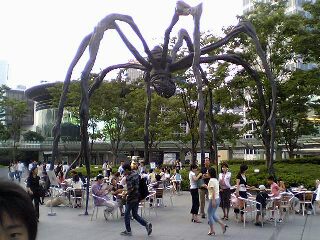
Art is used to lend Roppongi Hills, the massive land grab mall/office complex I’m loving hating these days, cultural credibility. Minoru Mori, the developer, clearly fancies his development is Tokyo’s Rockefeller Center–and, by extension, he’s Japan’s Rockefeller.
At least two pieces of large-scale sculpture that were previously shown at Rock Ctr are currently installed at Roppongi Hills: Takashi Murakami’s Mr. Pointy & co., and Louise Bourgeois’ Maman [above].
Maman was first shown at the Tate Modern’s Turbine Hall. But for some reason, organizers at neither previous venue thought to turn the work into a cafe.
Tokyo Snapshots, 2.3: Michelangelo’s David
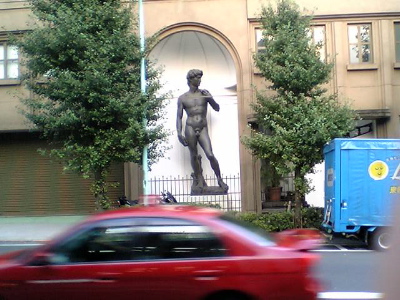
Walking along the street dividing Shibuya-ku and Minato-ku (ku’s are wards, as if the Lower East Side had its own government bureacracy), I was startled to find a life-sized bronze cast of Michelangelo’s David, as the central element in an ugly, low-rise concrete office building. There’s a granite plaque at the foot of the statue, but it only gives basic info on the original. And the stone’s grain is so pronounced, it’s nearly impossible to read. All very odd.
Tokyo Snapshots, 2.2: Women-Only Train Car
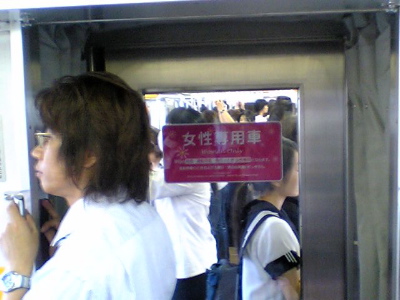
This is the entrance to the Women-only train car on the Tokyu line. There are enough pervs to require this sort of thing, it seems.
Meanwhile, although the Japanese have 42 different words for “excuse me,” there is no way to say “Rethink the hair.”
Tokyo Snapshots, 2.1: Waketokuyama, by Kengo Kuma
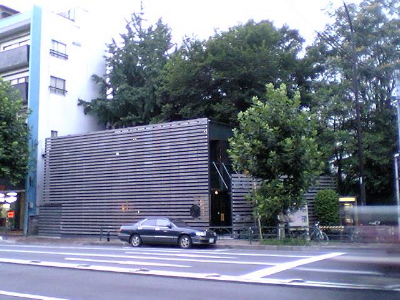
Near where we’ve been staying in Tokyo is this striking building, which I had to check out. The screen-like facade turns out to be cinder block-colored bricks set on end in a blackened steel frame. A meter back is the entry courtyard and the stark glass box of the restaurant, which feels suspended in the thick forest behind it. Of course, it’s on a busy corner of a major street (gaien higashi-doori, if you’re coming).
The restaurant is called Waketokuyama, and it’s apparently the Per Se of Tokyo, from the stunningly simple cuisine made with super-fresh ingredients, to the difficulties of getting a reservation. We’ll still look into eating there, but it was the architecture–by Kengo Kuma–which first caught my attention.
Kengo Kuma and Associates [kkaa.co.jp, such a big browser window for such little pictures]
Maybe They Should Read The Arts & Leisure Secion
The NYT Magazine has an excellent firsthand report from the set of Red vs. Blue. It turns out that a few scrappy creative types are actually making movies inside of video games. If this catches on, it could be revolutionary. I mean, it’s pretty funny to imagine those faceless soldiers in Halo having inner lives and existential crises. haha.
Now if only this upstart medium had a name…
8/05, 4,500 words: The X-Box Auteurs [nytmag]
Previously: Waiting for Halo; 11/04, like, 100 words: Virtual Warriors Have Feelings, Too [nyt]
Tokyo Snapshots, 1.5: Takashi Murakami Corp.
I still have a place in my heart–and fortunately, a spot in the old collection–for Takashi Murakami. The Louis Vuitton thing was rather masterful, and the sheer superfluity of luxury and fashion maps rather well onto some of the more expendable aspects of contemporary art, too.
Likewise, I’m not unappreciative of Murakami’s own creation myth, in which he and his characters subverted and exploited the banal world of Japanese idol-centric television, even as they were, in turn, exploited by the media for their own ends.
And when the set of Tongari-kun characters, including Mr. Pointy and his crew, was installed at Rockefeller Center, I was happy to go celebrate. [Here’s Gothamist’s report.]
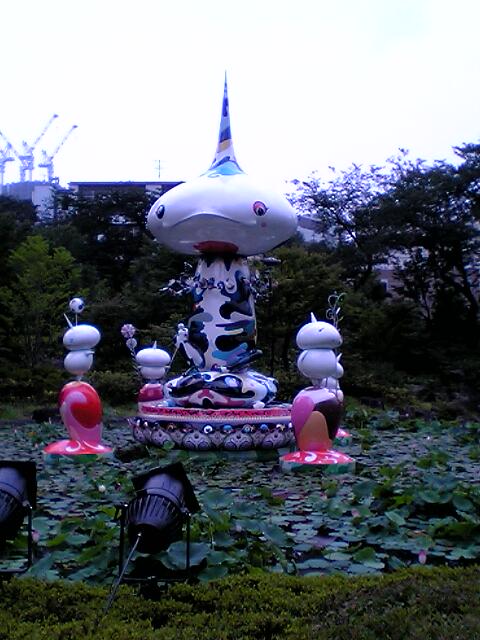
But for some reason, it gives me a creeped out, sinister feeling seeing the identity characters he licensed to the massive, city-soul-sucking Roppongi Hills development, and then seeing the whole place decked out with banners celebrating Murakami Month, aka the same Tongari-kun/ Mr. Pointy sculptures from two years ago, installed in a lotus pond at the complex’s center.
The Mori Art Museum and its adjacent mall are full of Murakami goods, of course, dolls, t-shirts, towels, stickers, but nothing sums up the uncritical celebration of megalomania and the unholy confluence of conscience-free art, urban planning, and commerce better than this: Roppongi Hills Monopoly, featuring Takashi Murakami’s characters. It’s about 5,000 yen. Of course, I bought it.
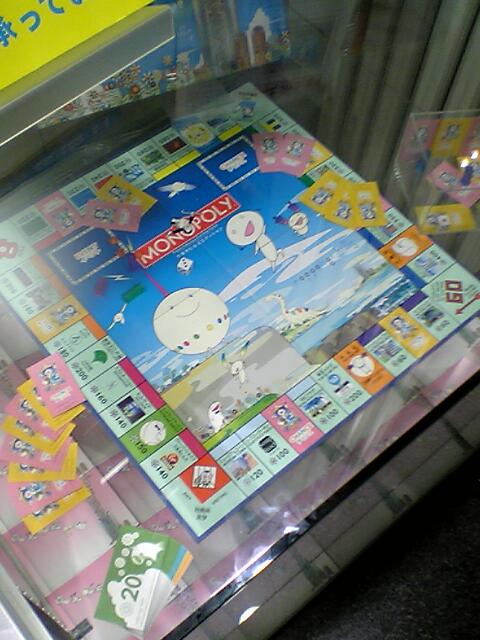
Tokyo Snapshots, 1.4: Tadao Ando Ruins Omotesando
This is the Tadao Ando building complex that the ego-mad developer Mori Minoru is finishing on Omotesando, what was once the heart of alternative cultural Tokyo. With a slew of LVMH brand glass curtained flagships all around it, it should really complete the look.
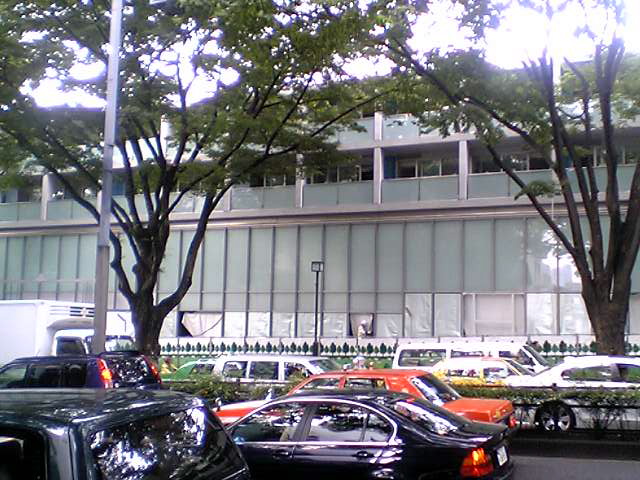
Tokyo Snapshots, 1.3: Sweet Muji Cardboard Shelving
Muji doesn’t inspire ecstatic fandom so much as subdued dedication. Otherwise, I’d turn into a screaming screaming junior high school girl every time I walked into one of their stores.
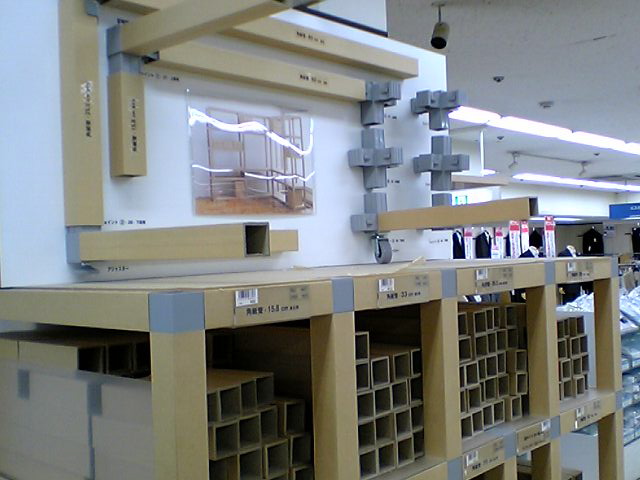
This Muji modular shelving system is one of five Muji products that received International Forum Design Awards in Hannover, Germany this year. Made from stiff, square-edged, recycled cardboard, and flush-fitted matte plastic joints, the system snaps together easily in a myriad of configurations. It’s clean and extremely functional, but yet it’s not thoroughly boring like most shelving. And it’s cheap, too.
You can see all the components online at the Muji net store [in japanese]
Square paper tube rack system [ifdesign.de]
Tokyo Snapshots, 1.2: Kawaii Gravestones
A gravestone shop I pass on the way from the hotel to the supermarket offers cute gravestones as an alternative to the traditional obelisk variety. I asked, and they’re not just for decorating your Japanese garden. Couldn’t bring myself to ask if they actually got permission from Sanrio and Disney for these, though. It didn’t seem polite.
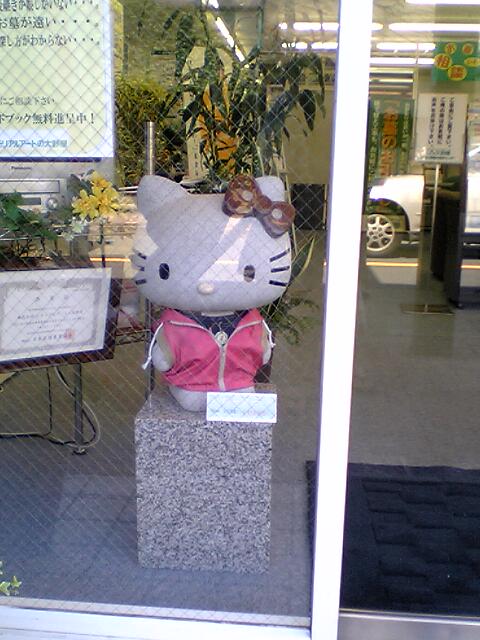
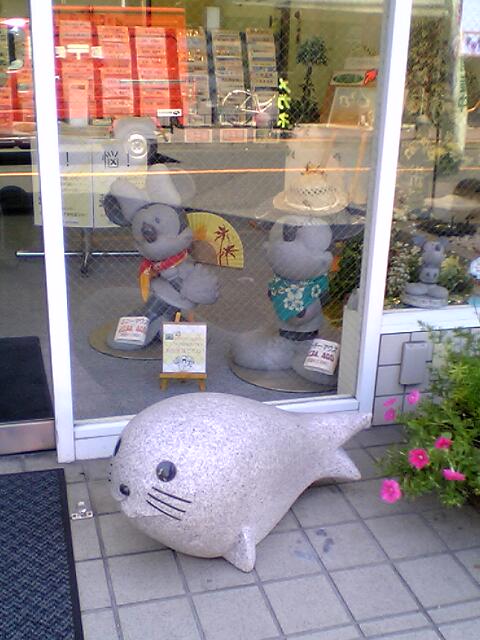
They’re about 140,000 yen each, and look like they were computer-carved from a smaller doll. The Kitty actually has a bow in contrasting red granite, and an actual hoodie, much like Degas’ Dancer has an actual tutu. Yes, I just compared Hello Kitty to Degas.
Tokyo Snapshots, 1.1: BSA Narcommercial
My thumbnail generator’s on the fritz, but here are some pictures I’ve taken around Tokyo using my Sharp TM-150. It’s pretty sweet for a phonecam, because it has a rather rare combination of decent megapixel camera and removable SD memory for cheap and easy mass image transfers.
First up is this Business Software Association commercial running on the Tokyu train:
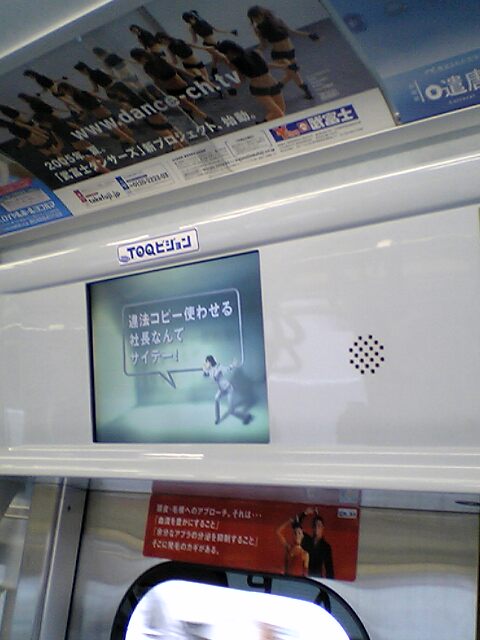
Translation: “Company presidents who make you use illegally copied software are the worst!!”
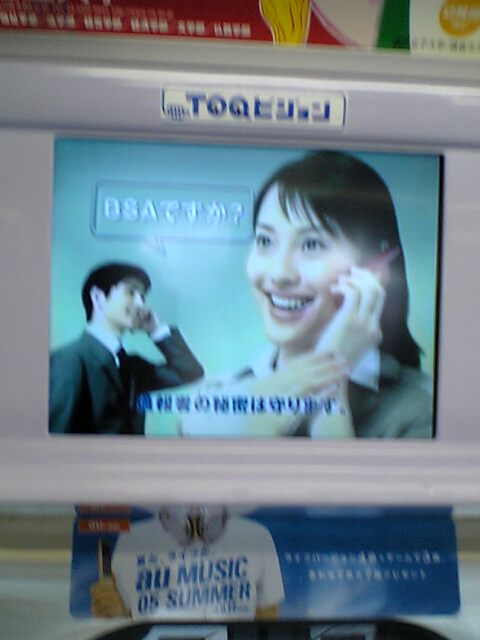
“Hello, is this BSA?”
A Million Penguin March On Tokyo, Change Trains With Ease, And Are So Over Ape T-Shirts
First of all, this whole Bathing Ape thing? Chill the flip out, people, it’s just not that cool. Bape is just Gap for the overly self-involved.
Anyway, TMN‘s mention of hopstop.com, a site for figuring out subway-to-subway trips in the city, reminds me it’s time to post about Norikae-Annai, aka Transfer Info, which is the same service for Tokyo.
It’s insanely helpful, if not as easy to start using cold; it gives you multiple trip options, indicating the fastest, cheapest, shortest on-train riding time… For untangling the spaghetti bowl that is Tokyo’s train/subway system, it’s pretty much indispensable.
I’ve got picture of Tadao Ando’s controversial new Jingumae apartment buildings nearing completion on Omotesando, the treelined main st of Harajuku. Ando’s concrete grid with a milky glass skin is starting to peek out of the scaffolding. Unfortunately, much of the opposite side of the street is now glass skin, too, so the street’s getting homogenized pretty quick. The interesting part of Ando’s buildings may be the courtyards, though. [Mori–who else?–tore down the Dojunkai Aoyama apartment buildings, revolutionary but crumbling 1927 concrete-and-ivy structures that served as incubators for much of the neighborhood’s alternative art and design scenes over the years. Oh well.]

Those penguins are everywhere. Remind me to include subjects in my next documentary that translate into cute plushtoys, because they have marched into every corner of the city.
On The Train From Tokyo
Around 7 o’clock on a crowded Sunday evening train away from Tokyo’s destination-filled southwest side (Roppongi, Aoyama, Shibuya, etc.), a couple in their late forties/early fifties sat quietly in the car’s corner seat. They were dressed, but not dressed up; he held a slim, pink, rather glossy shopping bag on his lap. They didn’t speak, but just sat quietly and contentedly next to each other. When you know someone that long, that well, a silent train ride home is barely a punctuation mark, an almost imperceptible breath in a decades-long conversation. Is that what it’s like to be old and married, I wonder?
Mamonaku Touka-Ichiba ni tsukimasu. Touka-Ichiba desu. They announce the next station, and the train begins to slow down. The man quietly hands the shopping bag to the woman, and they match glances and slight nods, or was it just the swaying train? No. Eyes forward, he gets up and joins the dozen or so people pressing out door. The woman, bag on lap, looks, not after him, but away, out the window. Not following his exit, she’s a woman who went into the city for the day. Maybe I–no, there’s a ring.
She adopted the precise mid-ground-focused gaze of Tokyo commuters; surrounded by people and ads and scenery and stuff, she expertly looked at nothing. She didn’t move much, except for the rocking of the train, until Machida, when we all shuffled onto the platform. She held the pink shopping bag and a small black purse in the crook of her arm as she left for home.
What Ere Thou Art, Act Well Thy Part
O me of little faith. Richard Dutcher, the guy who made the first Mormon niche film, God’s Army, goes around making sure he’s referred to as “The Mormon Spielberg.” Meanwhile, the guys at HaleStorm seem to have set their sights on becoming “The Mormon Farrelly brothers,” I guess. But with their new film, Church Ball, as they try to break out of the Mormon ghetto they helped define–and saturate with mediocre comedies–I think they’re well on their way to earning the title, “The Mormon Rawson Marshall Thurber,” and they’re welcome to it.
From the NYT puff piece hailing The New Mormon Wave of fogettable cinema:
So far, the price of cultural crossover seemed to be merely good-natured exasperation. As the cameras rolled, an actor unspooled streams of profanity, and Hale had to assure his extras, all Mormon, that the four-letter words would be dubbed over with a ref’s whistle.
The Cinema of Latter-Day Saints [nyt mag]
Also in the NYT Mag: Jim Jarmusch shows how it’s actually done.
Related? A guy who went to high school with Napoleon Dynamite producer Jeremy Coon is trying to out-filmmake him before their 2007 reunion. Good luck with that.
